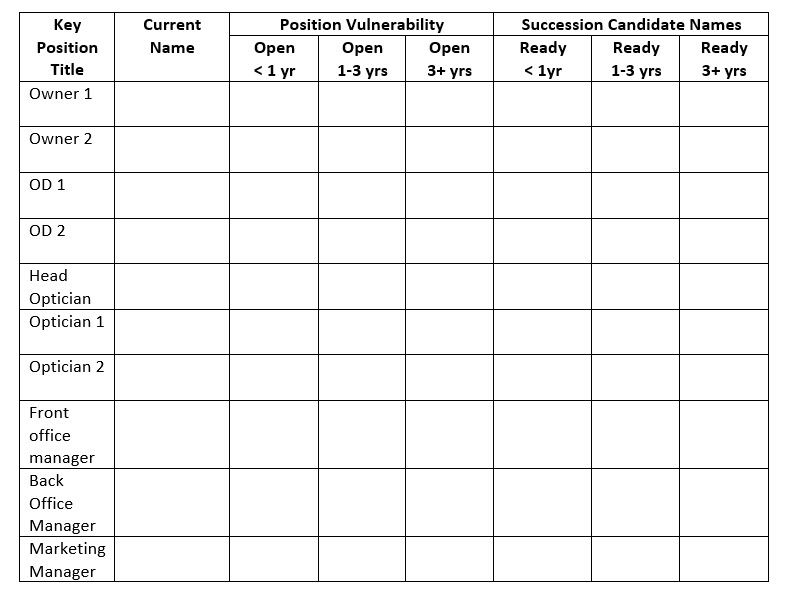By Mark Wright, OD, FCOVD,
and Carole Burns, OD, FCOVD

August 24, 2022
There are many challenges facing practices. In last week’s column, we addressed five of what we feel are the top 10 problems confronting practice owners. Here are the other five, along with suggested solutions for meeting these challenges.
• Supply Chain Issues
One of the biggest problems in a practice with supply chain issues shows up on the frame boards. It occurs because of a frame board management system flaw.
There are two major ways to manage your frame boards: Static and Dynamic. A static frame board management system is structured so that the frames on your frame boards are fixed (you do not send the frame in with the order) whereas in a dynamic frame board management system, the frame is taken off the board and sent in with the order.
The problem with a dynamic approach is that you may have taken your best-selling frame off the board and replaced it with a lower-selling frame until the best seller is restocked.
The fix for this problem is to move to a static frame board management system.
• Employee Retention Problems
One of the fundamental ideas in team management is to have the right people on the bus and each of those people in the right seat on the bus. When this does not happen, then problems (and with that, stress) increase for patients, team members and practice owners.
When it is easy to find new team members, that is called an Employer’s Market. When it is hard to find new team members, that is called an Employee’s Market. We are currently in an Employee’s Market. In an Employee’s Market it is essential to keep current employees on the bus. Employees know this and often take advantage of this situation to demand higher pay and more benefits.
Other Articles to Explore
So, how do you retain team members in an Employee’s Market? It takes a plan and work to adapt to human capital trends – to build a practice that retains its team. The past few years have shown people what they want and do not want in the workplace.
The fix starts with knowing your team. Start by surveying your team for what they want and do not want in the workplace. Lay that on top of what the practice owners want and do not want in the practice. Find areas of agreement.
Simultaneous with the team and owners survey, create a workflow map of your practice. Analyze the map to see opportunities where you can improve effectiveness and efficiency. Patients pick up very quickly if the office is a well-oiled machine or a stressed-out horrible workplace filled with unhappy people. Create the environment you want to live in with your team.
Pay appropriately. Pay enough to take money off the table as a negotiation issue. The most you can pay team members is 20-22 percent of gross revenue collected. The worst situation is when a team member says, “I’ve been here another year, so I’m expecting another raise.” The best approach is when the team member says, “I found a way we can improve the practice that will improve the gross revenue collected, and here’s what I think would be fair to both the practice and myself.”
Immediately people will say, “No one is going to say that.” We agree. Unless you teach them. And that is often where the ball gets dropped. Teach them.
• Sales Problems
In far too many practices, team members (including doctors) view their jobs as what they “do” versus what they “produce.”
Which would you rather have, an optician who is happy because of showing 400 frames today (with only 10 pairs sold) or an optician who sold 40 pairs of glasses today? That’s the difference between “do” and “produce.”
Often team members project their own financial situation upon patients. This results in team members looking for the least expensive path for patients. Rather than taking the approach of what is best for patients, some team members are looking for the least expensive route for patients.
The fix is to keep re-messaging team members that we are the patients’ eyecare professionals, not the patients’ bankers. Our goal is to improve our patients’ quality of life at home, school, work and play, not just prescribe what is the least expensive way to just get by.
• Not Asking for Help
How many of us evaluate team members based on best practices either year over year or by national norms? Most team evaluations we have found over the years are mostly subjective. Objective evaluations are necessary. From an objective analysis point of view, are you better this year than last year is the question we want answered.
If you are a full-time equivalent optometrist (i.e.: working 5 days/week, 8 hours/day, 50 weeks/year) you should be producing, at minimum, one million dollars of gross revenue collected per year. Any less and there is a problem somewhere that needs to be fixed. If you can’t find the problem or fix the problem, then it is time to ask for help.
The fix is to ask for help. Help can be found in a study group or consultants, or even asking a successful friend/mentor who has fixed the problem in their practice.
• No Exit Strategy
Most practices do not have a written succession plan. This is not fair to the practice, the team, the patients or even to the owner’s family. Far too often, something comes up and the practice is not ready to move from the current situation to the next.
Succession Planning is not just for the owners of the practice, it is also for key team members. What happens to the practice with the loss of opticians, marketing managers, back-office managers, etc.? Without planning, most of the time nothing good happens.
The fix is to create a written succession plan and keep key people aware of where the plan is located. This plan should be reviewed at least annually to make sure it is current and still workable.
Here is a starting place for your succession planning:

Now that you’ve considered all 10 of the problems, now is the time for action. Identify which problem is most important to your practice and begin working on the fixes.
>>Click HERE to read about the other five biggest problems facing practices>>























